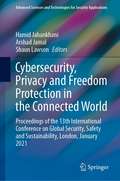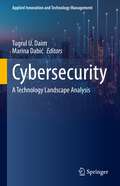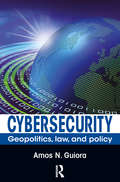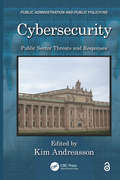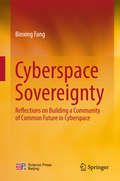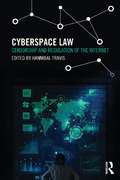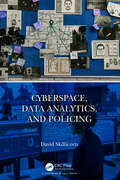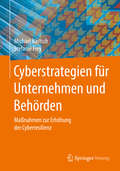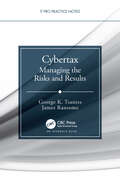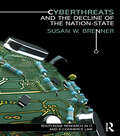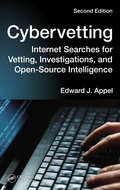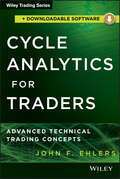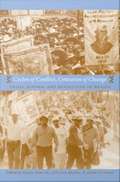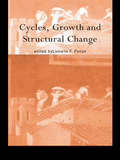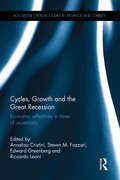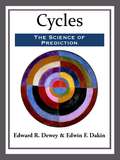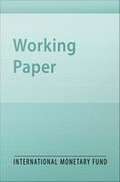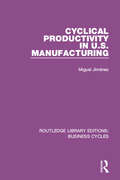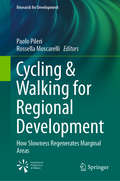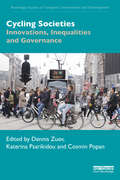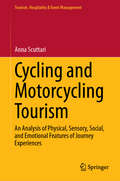- Table View
- List View
Cybersecurity, Privacy and Freedom Protection in the Connected World: Proceedings of the 13th International Conference on Global Security, Safety and Sustainability, London, January 2021 (Advanced Sciences and Technologies for Security Applications)
by Hamid Jahankhani Arshad Jamal Shaun LawsonThis book provides an opportunity for investigators, government officials, systems scientists, strategists, assurance researchers, owners, operators and maintainers of large, complex and advanced systems and infrastructures to update their knowledge with the state of best practice in the challenging domains whilst networking with the leading representatives, researchers and solution providers. Drawing on 12 years of successful events on information security, digital forensics and cyber-crime, the 13th ICGS3-20 conference aims to provide attendees with an information-packed agenda with representatives from across the industry and the globe. The challenges of complexity, rapid pace of change and risk/opportunity issues associated with modern products, systems, special events and infrastructures. In an era of unprecedented volatile, political and economic environment across the world, computer-based systems face ever more increasing challenges, disputes and responsibilities, and whilst the Internet has created a global platform for the exchange of ideas, goods and services, it has also created boundless opportunities for cyber-crime. As an increasing number of large organizations and individuals use the Internet and its satellite mobile technologies, they are increasingly vulnerable to cyber-crime threats. It is therefore paramount that the security industry raises its game to combat these threats. Whilst there is a huge adoption of technology and smart home devices, comparably, there is a rise of threat vector in the abuse of the technology in domestic violence inflicted through IoT too. All these are an issue of global importance as law enforcement agencies all over the world are struggling to cope.
Cybersecurity: A Technology Landscape Analysis (Applied Innovation and Technology Management)
by Tugrul U. Daim Marina DabićCybersecurity has become a critical area to focus after recent hack attacks to key infrastructure and personal systems. This book reviews the building blocks of cybersecurity technologies and demonstrates the application of various technology intelligence methods through big data. Each chapter uses a different mining method to analyze these technologies through different kinds of data such as patents, tweets, publications, presentations, and other sources. It also analyzes cybersecurity methods in sectors such as manufacturing, energy and healthcare.
Cybersecurity: Geopolitics, Law, and Policy
by Amos N. GuioraThis book examines the legal and policy aspects of cyber-security. It takes a much needed look at cyber-security from a geopolitical perspective. Through this lens, it seeks to broaden the reader's understanding of the legal and political considerations of individuals, corporations, law enforcement and regulatory bodies and management of the complex relationships between them. In drawing on interviews conducted with experts from a wide range of fields, the book presents the reader with dilemmas and paradigms that confront law makers, corporate leaders, law enforcement, and national leaders. The book is structured in a novel format by employing a series of vignettes which have been created as exercises intended to confront the reader with the dilemmas involved in cyber-security. Through the use of vignettes, the work seeks to highlight the constant threat of cyber-security against various audiences, with the overall aim of facilitating discussion and reaction to actual probable events. In this sense, the book seeks to provide recommendations for best practices in response to the complex and numerous threats related to cyber-security. This book will be of interest to students of cyber-security, terrorism, international law, security studies and IR in general, as well as policy makers, professionals and law-enforcement officials.
Cybersecurity: Public Sector Threats and Responses (Public Administration And Public Policy Ser.)
by Kim AndreassonThe Internet has given rise to new opportunities for the public sector to improve efficiency and better serve constituents. But with an increasing reliance on the Internet, digital tools are also exposing the public sector to new risks. This accessible primer focuses on the convergence of globalization, connectivity, and the migration of public sector functions online. It examines emerging trends and strategies from around the world and offers practical guidance for addressing contemporary risks. It supplies an overview of relevant U.S. Federal cyber incident response policies and outlines an organizational framework for assessing risk.
Cyberspace Sovereignty: Reflections On Building A Community Of Common Future In Cyberspace
by Binxing FangThis book is the first one that comprehensively discusses cyberspace sovereignty in China, reflecting China’s clear attitude in the global Internet governance: respecting every nation’s right to independently choose a development path, cyber management modes and Internet public policies and to participate in the international cyberspace governance on an equal footing. At present, the concept of cyberspace sovereignty is still very strange to many people, so it needs to be thoroughly analyzed. This book will not only help scientific and technical workers in the field of cyberspace security, law researchers and the public understand the development of cyberspace sovereignty at home and abroad, but also serve as reference basis for the relevant decision-making and management departments in their work.
Cyberspace Law: Censorship and Regulation of the Internet (Routledge Research in Information Technology and E-Commerce Law)
by Hannibal TravisThis book explores what the American Civil Liberties Union calls the "third era" in cyberspace, in which filters "fundamentally alter the architectural structure of the Internet, with significant implications for free speech." Although courts and nongovernmental organizations increasingly insist upon constitutional and other legal guarantees of a freewheeling Internet, multi-national corporations compete to produce tools and strategies for making it more predictable. When Google attempted to improve our access to information containing in books and the World Wide Web, copyright litigation began to tie up the process of making content searchable, and resulted in the wrongful removal of access to thousands if not millions of works. Just as the courts were insisting that using trademarks online to criticize their owners is First Amendment-protected, corporations and trade associations accelerated their development of ways to make Internet companies liable for their users’ infringing words and actions, potentially circumventing free speech rights. And as social networking and content-sharing sites have proliferated, so have the terms of service and content-detecting tools for detecting, flagging, and deleting content that makes one or another corporation or trade association fear for its image or profits. The book provides a legal history of Internet regulation since the mid-1990s, with a particular focus on efforts by patent, trademark, and copyright owners to compel Internet firms to monitor their online offerings and remove or pay for any violations of the rights of others. This book will be of interest to students of law, communications, political science, government and policy, business, and economics, as well as anyone interested in free speech and commerce on the internet.
Cyberspace, Data Analytics, and Policing
by David SkillicornCyberspace is changing the face of crime. For criminals it has become a place for rich collaboration and learning, not just within one country; and a place where new kinds of crimes can be carried out, and a vehicle for committing conventional crimes with unprecedented range, scale, and speed. Law enforcement faces a challenge in keeping up and dealing with this new environment. The news is not all bad – collecting and analyzing data about criminals and their activities can provide new levels of insight into what they are doing and how they are doing it. However, using data analytics requires a change of process and new skills that (so far) many law enforcement organizations have had difficulty leveraging. Cyberspace, Data Analytics, and Policing surveys the changes that cyberspace has brought to criminality and to policing with enough technical content to expose the issues and suggest ways in which law enforcement organizations can adapt. Key Features: Provides a non-technical but robust overview of how cyberspace enables new kinds of crime and changes existing crimes. Describes how criminals exploit the ability to communicate globally to learn, form groups, and acquire cybertools. Describes how law enforcement can use the ability to collect data and apply analytics to better protect society and to discover and prosecute criminals. Provides examples from open-source data of how hot spot and intelligence-led policing can benefit law enforcement. Describes how law enforcement can exploit the ability to communicate globally to collaborate in dealing with trans-national crime.
Cyberstrategien für Unternehmen und Behörden
by Michael Bartsch Stefanie FreyDie Autoren beschreiben in diesem Buch, wie eine Cybersicherheitsstrategie entwickelt und umgesetzt wird. Dabei beleuchten sie die geopolitischen Einflüsse wie auch die organisatorischen und technischen Rahmenbedingungen. Cyberrisiken entstehen durch den Einsatz von Informationstechnologien, beinhalten aber auch organisatorische und technische Risiken und sind somit nicht nur ein Problem der IT-Abteilung, sondern der Unternehmensleitung. Eine Cyberstrategie sollte daher ein Teil der Unternehmensstrategie sein und nicht nur ein Teil der IT-Strategie.Die staatliche und die unternehmerische Sicherheitsvorsorge werden bei der Cyberproblematik immer enger zusammenarbeiten müssen. Nur so können Wirtschafträume im Cyberspace langfristig gesichert werden.
Cybertax: Managing the Risks and Results (IT Pro Practice Notes)
by James Ransome George K. TsantesCybersecurity risk is a top-of-the-house issue for all organizations. Cybertax—Managing the Risks and Results is a must read for every current or aspiring executive seeking the best way to manage and mitigate cybersecurity risk. It examines cybersecurity as a tax on the organization and charts the best ways leadership can be cybertax efficient. Viewing cybersecurity through the cybertax lens provides an effective way for non–cybersecurity experts in leadership to manage and govern cybersecurity in their organizations The book outlines questions and leadership techniques to gain the relevant information to manage cybersecurity threats and risk. The book enables executives to: Understand cybersecurity risk from a business perspective Understand cybersecurity risk as a tax (cybertax) Understand the cybersecurity threat landscape Drive business-driven questions and metrics for managing cybersecurity risk Understand the Seven C’s for managing cybersecurity risk Governing the cybersecurity function is as important as governing finance, sales, human resources, and other key leadership responsibilities Executive leadership needs to manage cybersecurity risk like they manage other critical risks, such as sales, finances, resources, and competition. This book puts managing cybersecurity risk on an even plane with these other significant risks that demand leaderships’ attention. The authors strive to demystify cybersecurity to bridge the chasm from the top-of-the-house to the cybersecurity function. This book delivers actionable advice and metrics to measure and evaluate cybersecurity effectiveness across your organization.
Cybertech Project (A)
by David M. UptonDescribes the development and exploitation of a radical new computer-integrated technology in the largely manual meat-processing industry. The technology has been developed by the meat industry's research organization over a period of 15 years and is now ready for commercial exploitation. Unfortunately, it is not clear how the industry can use the technology because its scale demands larger firms than currently exist and its operation requires expertise that the industry does not have. The commercializing firm is also under pressure to break the system into smaller modules, losing some of the benefits of computer integration, but gaining a dissemination path. There is another model for improvement in the industry, relying on incremental improvement, rather than radical technology change, and many have said that the project is doomed, because it might not provide the best path to improvement in the industry.
Cyberthreats and the Decline of the Nation-State: Cyberthreats And The Decline Of The Nation-state (Routledge Research in Information Technology and E-Commerce Law)
by Susan W. BrennerThis book explores the extraordinary difficulties a nation-state’s law enforcement and military face in attempting to prevent cyber-attacks. In the wake of recent assaults including the denial of service attack on Estonia in 2007 and the widespread use of the Zeus Trojan Horse software, Susan W. Brenner explores how traditional categories and procedures inherent in law enforcement and military agencies can obstruct efforts to respond to cyberthreats. Brenner argues that the use of a territorially-based system of sovereignty to combat cyberthreats is ineffective, as cyberspace erodes the import of territory. This problem is compounded by the nature of cybercrime as a continually evolving phenomenon driven by rapid and complex technological change. Following an evaluation of the efficacy of the nation-state, the book goes on to explore how individuals and corporations could be integrated into a more decentralized, distributed system of cyberthreat control. Looking at initiatives in Estonia and Sweden which have attempted to incorporate civilians into their cyber-response efforts, Brenner suggests that civilian involvement may mediate the rigid hierarchies that exist among formal agencies and increase the flexibility of any response. This book will be of great interest to students and researchers of information technological law and security studies.
Cybervetting: Internet Searches for Vetting, Investigations, and Open-Source Intelligence, Second Edition
by Edward J. AppelResearching an individual‘s, firm‘s or brands online presence has become standard practice for many employers, investigators, and intelligence officers, including law enforcement. Countless companies and organizations are implementing their own policies, procedures, and practices for Internet investigations, cybervetting, and intelligence.
Cycle Analytics for Traders + Downloadable Software
by John F. EhlersA technical resource for self-directed traders who want to understand the scientific underpinnings of the filters and indicators used in trading decisionsThis is a technical resource book written for self-directed traders who want to understand the scientific underpinnings of the filters and indicators they use in their trading decisions. There is plenty of theory and years of research behind the unique solutions provided in this book, but the emphasis is on simplicity rather than mathematical purity. In particular, the solutions use a pragmatic approach to attain effective trading results. Cycle Analytics for Traders will allow traders to think of their indicators and trading strategies in the frequency domain as well as their motions in the time domain. This new viewpoint will enable them to select the most efficient filter lengths for the job at hand.Shows an awareness of Spectral Dilation, and how to eliminate it or to use it to your advantageDiscusses how to use Automatic Gain Control (AGC) to normalize indicator amplitude swingsExplains thinking of prices in the frequency domain as well as in the time domainCreates an awareness that all indicators are statistical rather than absolute, as implied by their single line displaysSheds light on several advanced cookbook filtersShowcases new advanced indicators like the Even Better Sinewave and Decycler IndicatorsExplains how to use transforms to improve the display and interpretation of indicators
Cycle for Survival (A)
by Das Narayandas Kerry Herman Noah FisherKatie Kotkins, director of Memorial Sloan Kettering Cancer Center's (MSKCC) Cycle for Survival fundraising event, had to determine the best avenue for continuing the event's success and momentum after its founder, Jennifer (Jen) Goodman Linn (HBS '99) passed away from MFH sarcoma. Jen and her husband, David Linn (HBS '00), had founded Cycle for Survival in 2007 as a way for Jen to give back to the community of doctors that had treated her since her diagnosis in 2003. The indoor cycling event had grown rapidly, and increased fundraising from $250,000 in 2007 to $4.7 million in 2011. After the event's second year, Jen and David made the decision to hand over control to MSKCC, partner with Equinox, and expand the event's fundraising efforts. At the time of Jen's passing Kotkins was focused on the 2013 event, but was faced with a series of strategic questions after losing the event's face and inspiration.
Cycle for Survival (B)
by Das Narayandas Kerry Herman Noah FisherUpdate on Cycle for Survival's 2012, 2013, and 2014 events. Kotkins and Cycle for Survival continued the event's strong growth, and underwent the first phase of a two-year rebranding effort.
Cycles in the UK Housing Economy: Price and its Relationship with Lenders, Buyers, Consumption and Construction
by David GrayThis book uses empirical research to examine fluctuations and periodicities in housing markets in the United Kingdom. Chapters investigate received wisdom on housing market co-determination before exploring an unconventional approach to analysing the interaction and diffusion evidence base. Finally, the author presents varied case studies, analysing price diffusion across first-time and repeat buyer groups, regions and housing vintages, as well as related macro variables. This volume will be of interest to academics and researchers interested in the area of price diffusion across housing markets.
Cycles of Conflict, Centuries of Change: Crisis, Reform, and Revolution in Mexico
by Elisa Servín Leticia Reina John TutinoThis important collection explores how Mexico's tumultuous past informs its uncertain present and future. Cycles of crisis and reform, of conflict and change, have marked Mexico's modern history. The final decades of the eighteenth, nineteenth, and twentieth centuries each brought efforts to integrate Mexico into globalizing economies, pressures on the country's diverse peoples, and attempts at reform. The crises of the late eighteenth century and the late nineteenth led to revolutionary mobilizations and violent regime changes. The wars for independence that began in 1810 triggered conflicts that endured for decades; the national revolution that began in 1910 shaped Mexico for most of the twentieth century. In 2000, the PRI, which had ruled for more than seventy years, was defeated in an election some hailed as "revolution by ballot. " Mexico now struggles with the legacies of a late-twentieth-century crisis defined by accelerating globalization and the breakdown of an authoritarian regime that was increasingly unresponsive to historic mandates and popular demands. Leading Mexicanists--historians and social scientists from Mexico, the United States, and Europe--examine the three fin-de-sicle eras of crisis. They focus on the role of the country's communities in advocating change from the eighteenth century to the present. They compare Mexico's revolutions of 1810 and 1910 and consider whether there might be a twenty-first-century recurrence or whether a globalizing, urbanizing, and democratizing world has so changed Mexico that revolution is improbable. Reflecting on the political changes and social challenges of the late twentieth century, the contributors ask if a democratic transition is possible and, if so, whether it is sufficient to address twenty-first-century demands for participation and justice. Contributors. Antonio Annino, Guillermo de la Pea, Franois-Xavier Guerra, Friedrich Katz, Alan Knight, Lorenzo Meyer, Leticia Reina, Enrique Semo, Elisa Servn, John Tutino, Eric Van Young
Cycles, Growth and Structural Change: Theories And Empirical Evidence (Routledge Siena Studies in Political Economy #Vol. 3)
by Lionello F PunzoThis volume gathers together key new contributions on the subject of the relationship, both empirical and theoretical, between economic oscillations, growth and structural change. Employing a sophisticated level of mathematical modelling, the collection contains articles from, amongst others, William Baumol, Katsuhito Iwai and William Brock.
Cycles, Growth and the Great Recession (Routledge Critical Studies in Finance and Stability)
by Edward Greenberg Annalisa Cristini Stephen Fazzari Riccardo LeoniCycles, Growth and the Great Recession is a collection of papers that assess the nature and role of the business cycle in contemporary economies. These assessments are made in the context of the financial market instability that distinguishes the Great Recession from previous post-war slowdowns. Theorists and applied scholars in the fields of economics and mathematical economics discuss various approaches to understanding cycles and growth, and present mathematical and applied macro models to show how uncertainty shapes cycles by affecting the economic agent choice. Also included is an empirical section that investigates how the Great Recession affected households’ housing wealth, labour productivity and migration decisions. This book aims to: Propose a novel understanding of the business cycle by comparing the approaches of various scholars, starting from Hyman Minsky and Piero Ferri. Show that uncertainty is a main feature of the business cycle that affects decision-making and economic behaviour in general. Explain with mathematical models how the behaviour of economic agents can lead to cyclical paths for modern developed economies. Augment theory with empirical analysis of some central issues related to the Great Recession. This book comprises an original view of such widely discussed subjects as business cycles, uncertainty, economic growth and the Great Recession, constructed around theory, models and applications.
Cycles: The Science of Prediction
by Edward R. DeweyIt is the business of science to predict. An exact science like astronomy can usually make very accurate predictions indeed. A chemist makes a precise prediction every time he writes a formula. The nuclear physicist advertised to the world, in the atomic bomb, how man can deal with entities so small that they are completely beyond the realm of sense perception, yet make predictions astonishing in their accuracy and significance. Economics is now reaching a point where it can hope also to make rather accurate predictions, within limits which this study will explain. This is the only eBook edition that comes complete with more than 150 graphs and charts.
Cyclical Patterns of Government Expenditures in Sub-Saharan Africa: Facts and Factors
by Irene Yackovlev Victor Lledó Lucie GadenneA report from the International Monetary Fund.
Cyclical Productivity in US Manufacturing (Routledge Library Editions: Business Cycles)
by Miguel JimenezThis book presents several pieces of empirical work which disentangle why the standard measure of productivity growth used in macroeconomics turn out to be procyclical for American manufacturing industries. Procyclical productivity is an essential feature of business cycles because of its important implications for macroeconomic modelling. The author explains why traditional Keynesian theories of the business cycle do not explain satisfactorily why productivity is procyclical, and argues that the force of technology for generating economic cycles is much more important than that of the management or mismanagement of monetary or fiscal policies. This book is aimed at those working in empirical macroeconomics but also industrial economics.
Cycling & Walking for Regional Development: How Slowness Regenerates Marginal Areas (Research for Development)
by Paolo Pileri Rossella MoscarelliThis book investigates why and how cycle and walking paths can help to promote the regeneration of marginalized areas facing depopulation and economic decline. In addition, it offers a broad overview of recent scientific research into slow tourism and marginality/spatial inequality and explores the linkages between these topics. Key issues are addressed by experts from various disciplinary backgrounds, and potential measures are proposed for the integration of slow tourism into strategies for regional development. Particular attention is devoted to the VENTO project, which involves the creation of a 700-km-long cycle route from Venice to Turin that passes through various rural and marginalized areas of northern Italy. The goal, research process, design, and early lessons from this important project are all discussed in detail. Moreover, the book describes policies and strategies that have successfully been used to enhance the slow tourism infrastructure in other European countries. Given its scope, the book will appeal to researchers, professionals, and students interested in e.g. policymaking, tourism planning, regional development, and landscape and urban planning.
Cycling Societies: Innovations, Inequalities and Governance (Routledge Studies in Transport, Environment and Development)
by Dennis Zuev; Katerina Psarikidou; Cosmin PopanThis book examines emerging debates and questions around cycling to critically analyse and challenge dominant framings and prevalent conventions of ‘good cycling’. Cycling Societies brings to light the plurality of voices and forms of cycling in other societies, revealing the diversity and complexity of cycling across different socio-political regimes, geographies and cultures. It presents case studies from five continents and demonstrates the need of thinking comparatively about cycling and urban environments. The book pivots around the three themes of innovations, inequalities and governance and engages a diversity of voices: world-renowned academics in the field of cycling and urban mobility, cycling activists and transportation consultants. Synthesising academic contributions with policy briefs, this innovative book will be of great interest to students, scholars and practitioners of sustainable transportation, urban planning and mobility studies.
Cycling and Motorcycling Tourism: An Analysis of Physical, Sensory, Social, and Emotional Features of Journey Experiences (Tourism, Hospitality & Event Management)
by Anna ScuttariThis book explores the understanding, description, and measurement of the physical, sensory, social, and emotional features of motorcycle and bicycle journey experiences in tourism. Novel insights are presented from an original case study of these forms of tourism in the Sella Pass, a panoramic road close to the Dolomites UNESCO World Heritage Site. A comprehensive mixed-methods strategy was employed for this research, with concurrent use of quantitative and qualitative methods including documentation and secondary data analysis, mobile video ethnography, and emotion measurement. The aim was to create a holistic knowledge of the features of journey experiences and a new definition of the mobility space as a perceptual space. The book is significant in that it is among the first studies to explore the concept of journey experiences and to develop an interdisciplinary theoretical foundation of mobility spaces. It offers a comprehensive understanding and a benchmarking of the features of motorcycling and cycling journey experiences, a deeper market knowledge on motorcycling and cycling tourists, and a set of tools, techniques, and recommendations for future research on tourist experiences.
